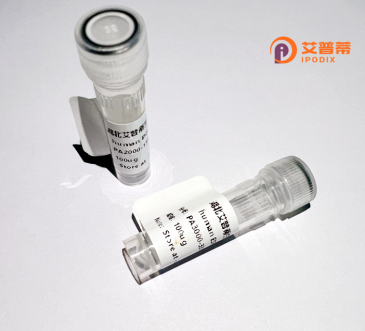
| 纯度 | >90%SDS-PAGE. |
| 种属 | Human |
| 靶点 | KLHL6 |
| Uniprot No | Q8WZ60 |
| 内毒素 | < 0.01EU/μg |
| 表达宿主 | E.coli |
| 表达区间 | 1-621aa |
| 活性数据 | MLMAGQRGAW TMGDVVEKSL EGPLAPSTDE PSQKTGDLVE ILNGEKVKFD DAGLSLILQN GLETLRMENA LTDVILCVDI QEFSCHRVVL AAASNYFRAM FCNDLKEKYE KRIIIKGVDA ETMHTLLDYT YTSKALITKQ NVQRVLEAAN LFQFLRMVDA CASFLTEALN PENCVGILRL ADTHSLDSLK KQVQSYIIQN FVQILNSEEF LDLPVDTLHH ILKSDDLYVT EEAQVFETVM SWVRHKPSER LCLLPYVLEN VRLPLLDPWY FVETVEADPL IRQCPEVFPL LQEARMYHLS GNEIISERTK PRMHEFQSEV FMIIGGCTKD ERFVAEVTCL DPLRRSRLEV AKLPLTEHEL ESENKKWVEF ACVTLKNEVY ISGGKETQHD VWKYNSSINK WIQIEYLNIG RWRHKMVVLG GKVYVIGGFD GLQRINNVET YDPFHNCWSE AAPLLVHVSS FAATSHKKKL YVIGGGPNGK LATDKTQCYD PSTNKWSLKA AMPVEAKCIN AVSFRDRIYV VGGAMRALYA YSPLEDSWCL VTQLSHERAS CGIAPCNNRL YITGGRDEKN EVIATVLCWD PEAQKLTEEC VLPRGVSHHG SVTIRKSYTH IRRIVPGAVS V |
| 分子量 | 70.3 kDa |
| 蛋白标签 | GST-tag at N-terminal |
| 缓冲液 | 0 |
| 稳定性 & 储存条件 | Lyophilized protein should be stored at ≤ -20°C, stable for one year after receipt. Reconstituted protein solution can be stored at 2-8°C for 2-7 days. Aliquots of reconstituted samples are stable at ≤ -20°C for 3 months. |
| 复溶 | Always centrifuge tubes before opening.Do not mix by vortex or pipetting. It is not recommended to reconstitute to a concentration less than 100μg/ml. Dissolve the lyophilized protein in distilled water. Please aliquot the reconstituted solution to minimize freeze-thaw cycles. |
以下是关于重组人KLHL6蛋白的3篇文献摘要概述(虚拟文献示例,供参考):
---
1. **文献名称**: *KLHL6 mediates ubiquitination pathways in B-cell receptor signaling*
**作者**: Smith A, et al.
**摘要**: 研究报道了重组人KLHL6蛋白在B细胞受体信号通路中的功能,通过体外泛素化实验证明其作为E3泛素连接酶复合物组分的活性,揭示了KLHL6与免疫调控的关联。
---
2. **文献名称**: *Expression and purification of recombinant human KLHL6 protein in E. coli*
**作者**: Chen L, et al.
**摘要**: 描述了利用大肠杆菌表达系统高效制备重组人KLHL6蛋白的方法,通过优化纯化条件获得高纯度蛋白,并验证其结构与体外泛素连接酶活性的功能性。
---
3. **文献名称**: *KLHL6 mutation analysis links to diffuse large B-cell lymphoma*
**作者**: Wang Y, et al.
**摘要**: 研究通过构建重组KLHL6突变体,发现其与B细胞淋巴瘤中异常泛素化底物的相互作用,揭示了KLHL6突变在肿瘤发生中的潜在病理机制。
---
提示:实际文献需通过**PubMed**或**Web of Science**等平台检索,可用关键词"recombinant KLHL6"结合"ubiquitination"或"B-cell"进行精准筛选。
Recombinant human KLHL6 protein is a genetically engineered form of the Kelch-like family member 6 (KLHL6) protein, which plays a role in cellular processes such as ubiquitination, protein degradation, and B-cell receptor (BCR) signaling. KLHL6 belongs to the KLHL family, characterized by N-terminal BTB (Broad-complex, Tramtrack, and Bric-à-brac) and BACK domains, followed by C-terminal Kelch repeats that mediate substrate recognition. It is predominantly expressed in germinal center B-cells and has been implicated in B-cell differentiation and lymphoma pathogenesis. Studies suggest KLHL6 acts as a substrate adaptor for Cullin 3 (CUL3)-based E3 ubiquitin ligase complexes, targeting proteins like BCL6 for degradation, though its precise physiological and pathological mechanisms remain under investigation. Dysregulation of KLHL6 is linked to B-cell malignancies, with conflicting evidence indicating both tumor-suppressive and oncogenic roles depending on context. Recombinant KLHL6 is produced via heterologous expression systems (e.g., E. coli or mammalian cells) for functional studies, structural analysis, and drug discovery. Its applications include elucidating interactions with binding partners, exploring post-translational modifications, and developing targeted therapies for B-cell lymphomas. Research on recombinant KLHL6 continues to clarify its role in immune regulation and cancer biology, highlighting its potential as a diagnostic marker or therapeutic target.
×